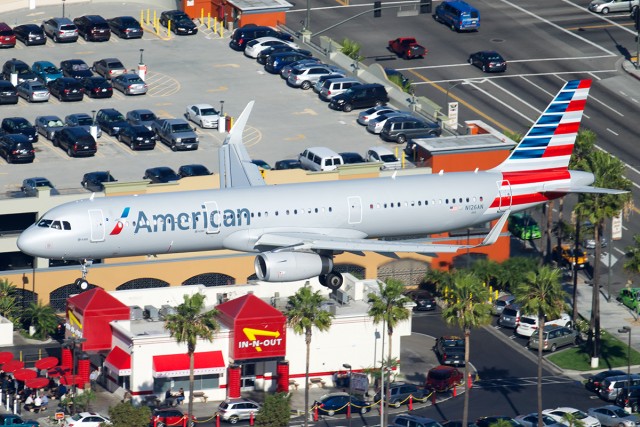
American A321 on final at LAX. AA could be a potential customer for the new variant – Photo: Bernie Leighton | AirlineReporter
Airbus has done what analysts have been expecting for the past few months; announce a version of the A321 with the ability to fly a greatly extended range and finally match (and exceed) the capabilities of a Boeing 757-200 with winglets.
The 97-ton maximum weight will be achieved by the addition of a fuel tank in the forward baggage compartment and some fairly low-cost reengineering of the wing. Air Lease Corporation is the launch customer, with a memorandum of understanding for thirty frames. They have not, yet, stated where these aircraft will be placed.
To achieve a 4000-nm range, Airbus has envisioned a configuration carrying 206 passengers (16J and 190Y). They have also stated that, due to the extra fuel tank and limitations of the design, it is unlikely for this aircraft to be able to carry much cargo. This may, immediately, appear as a source of consternation if your airline relies on flying long sorties on narrow-bodies full of fresh fish. Otherwise, is it really a big deal? I would say no.
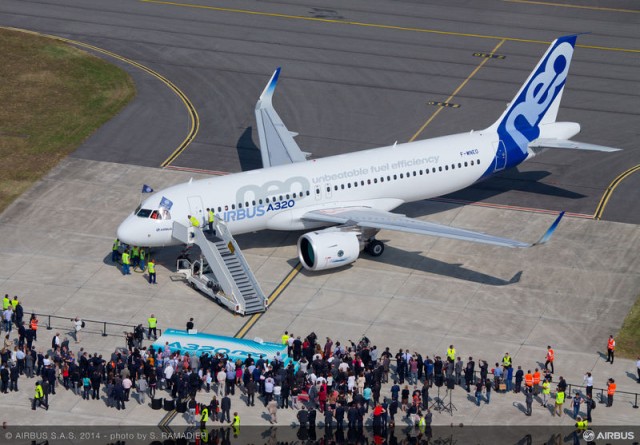
People gathered at Toulouse-Blagnac Airport on 25 September 2014 to witness the historic first “neo” flight – Photo: Airbus
Recently, Leeham News broke news to the world that Airbus is offering a new variant of the A321neo. This aircraft, dubbed the A321neoLR (rolls right off the tongue, right?) is set to extend the range of the aircraft an additional 400-500 nautical miles (nm) over the standard A321neo (now slated to be around the 4,000 nm mark). Airbus has confirmed the aircraft, according to Leeham, and they say that it will have a 100 nm range advantage over the 757-200W, the variant used primarily for trans-Atlantic flights.
Is this new aircraft the death knell finally for the 757?
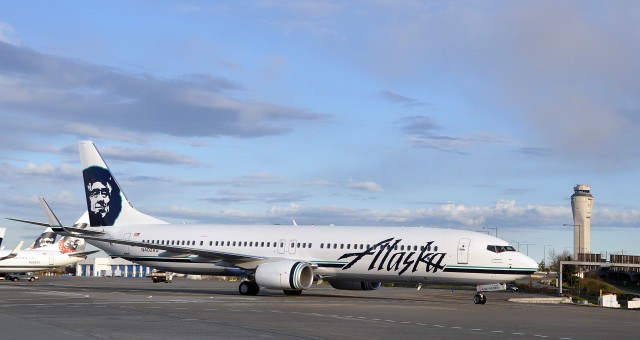
The 737-900ER is a popular choice as a longer-range aircraft to replace older 757s, but is it the right fit? Photo: Alaska Airlines
We have looked multiple times at the differences between the 757 & the A321. The two aircraft have always gone back and forth as apparent direct competitors and even the new 737-900ER, which seem to be extremely popular with airlines like Delta, Alaska or the Lion Air Group from Indonesia, can’t seem to replace the 757.
What keeps Boeing from producing a new aircraft to properly replace the 757?

Throughout its fifteen year history, JetBlue Airways has worked hard to be the blue-collar airline with an upscale image. With popular features such as DirecTV and SiriusXM entertainment at every seat, the most legroom in coach of any US-based airline, and, most recently FlyFi wireless onboard internet connectivity, the airline has put the passenger experience at the forefront.
Now, the airline is poised to launch the next generation of its onboard product. Dubbed “Mint”, the service will initially be offered exclusively on its route between New York and Los Angeles, with flights to San Fransisco set to follow later this year. I recently had the chance to preview the new product at JFK and wanted to share what I discorvered.
-
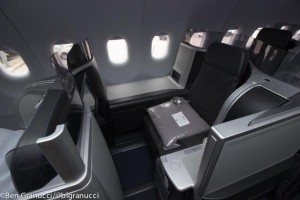
-
A Mint mini-suite
-
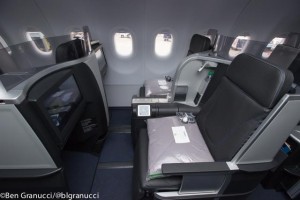
-
A row of two Mint seats
The new Mint Experience is a wholesale, multi-faceted upgrade of the traditional JetBlue product. Offered exclusively on a subfleet of the carrier’s Airbus A321 aircraft, Mint provides a true premium product to compete with the other four carriers flying in the transcontinental market. The most noticeable change onboard is to the seat.
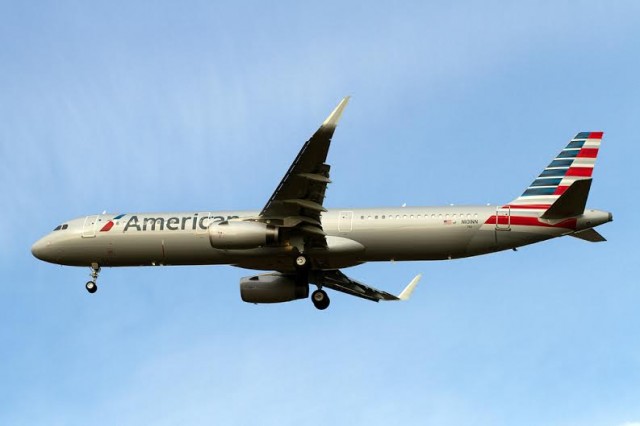
American’s new Airbus A321 in flight – Photo: Eric Dunetz
A while back, I viewed a tweet about an Air Traffic Control (ATC) conversation in New York, where JFK ATC got a little bit confused about an aircraft type. American Airlines (AA) Flight 32 was incorrectly called a ’œheavy’ aircraft, likely because for so long that flight was operated by a Boeing 767-200. Ever since AA debuted their new Airbus A321 on the LAX-JFK route, this flight no longer needs to use the “heavy” designation, but that didn’t stop the ATC staff from using old habits. It made me question, at what point does an aircraft become ’œheavy’?
When aircraft are approaching or departing an airport, they must use special designations to help avoid the wake turbulence from other aircraft. Larger aircraft, like a 767 or an A340, need more space behind them to prevent the wake vortices generated by the larger wing span from impacting other aircraft. The bigger the aircraft, the longer the distance.
The dangers are real, as all over the world a number of incidents have occurred that can be attributed to a wake vortex. From the crash of an XB-70 in the 60’s to some involving more modern aircraft in the last 10 years (including an A380 in Sydney).
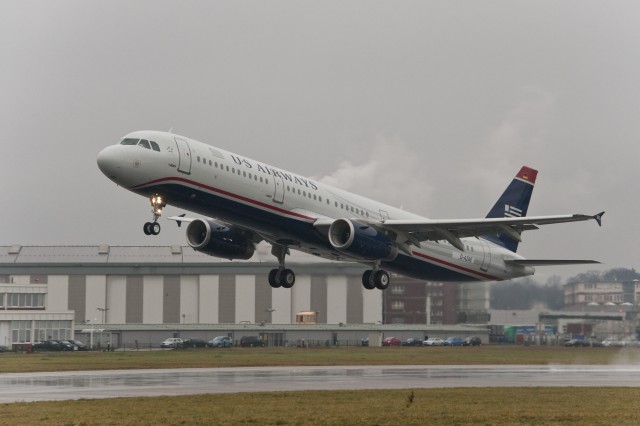
HI-RES PIC (click for larger): The 7000th Airbus aircraft, an A321 for US Airways, takes off. Check the German flag on the tail. Photo from Airbus.
Airbus was originally founded in 1970 as a consortium of aerospace manufactures to better compete with Boeing, McDonnell Douglas and Lockheed. Their first aircraft was the A300, which first flight on October 28, 1972 and since then, the manufacture has created many successful aircraft that have flown millions of passengers around the world. A big milestone was reached by the company on December 12th; Airbus delivered its 7000th plane. The special aircraft was an A321 that was delivered to US Airways.
’œIt’s particularly fitting that our 7,000th aircraft is an A321 going to US Airways. The airline not only operates the largest fleet of Airbus aircraft in the world; with over 220 A320 Family aircraft flying in US Airways colours today,’ said Tom Enders, Airbus President and CEO. ’œThis milestone is a tribute to the hard work and commitment of Airbus teams around the world. We have improved efficiencies company-wide and this has enabled us to deliver record numbers of latest generation aircraft at continually increasing rates, with an environmental footprint ever decreasing.’
It was only two short years ago that Airbus delivered their 6000th aircraft, which was an A380 for Emirates in January 2010.
As of November, 2011, Airbus has received a total of 11,438 orders, with 816 for the A300/A310 family, 8251 for the A320 family, 2128 for the A330/A340/A350 family and 243 for the A380.
A big congrats to Airbus on their 7000th delivery, let’s see how long it takes to make the 8000 mark.







